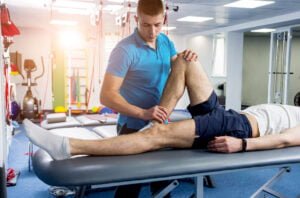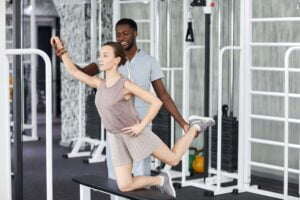Physical prowess and athletic excellence go hand in hand, but the journey to peak performance is often riddled with challenges that can take a toll on an athlete’s body. This is where physical therapy steps in, serving as a vital component in an athlete’s training regimen. In this comprehensive guide, we delve into the world of physical therapy for athletes, exploring its benefits, techniques, and the crucial role it plays in ensuring both injury prevention and performance enhancement.
Contents
- 1 Understanding Athlete-Specific Needs
- 2 Role of Physical Therapy in Injury Prevention
- 3 Techniques of Physical Therapy for Athletes
- 4 Enhancing Performance in Physical Therapy for Athletes
- 5 Incorporating Advanced Technologies in Physical Therapy for Athletes
- 6 Nutrition Therapy for Athletes
- 7 Collaboration with Sports Coaches
- 8 Conclusion
Understanding Athlete-Specific Needs
Athletes subject their bodies to intense physical demands, which often lead to stress, strain, and even injuries. The repetitive motions and rigorous training regimens can result in overuse injuries. This is where the expertise of physical therapists comes into play. They understand the unique challenges athletes face and tailor their approaches to address these specific needs.
Role of Physical Therapy in Injury Prevention

Prevention is the cornerstone of an athlete’s longevity and success. Physical therapists focus on enhancing flexibility, mobility, and strength to create a sturdy foundation for an athlete’s body. By identifying and addressing imbalances or weaknesses, they help minimize the risk of injuries that could sideline an athlete. Some of the key roles of physical therapy are:
- Injury Prevention: Physical therapists assess an athlete’s movement patterns, identify weaknesses, and create tailored exercise programs to address these issues. This proactive approach helps prevent injuries by correcting imbalances before they escalate into more significant problems.
- Performance Enhancement: Beyond injury prevention, physical therapy can enhance an athlete’s performance. By improving mobility, flexibility, strength, and functional movement, athletes can achieve greater efficiency in their movements, leading to improved performance metrics.
- Post-Injury Rehabilitation: When injuries do occur, physical therapy plays a pivotal role in the rehabilitation process. Physical therapists design rehabilitation programs that facilitate a safe and efficient return to sport, focusing on rebuilding strength, restoring range of motion, and improving proprioception.
- Pain Management: Chronic pain can be a hindrance to both training and performance. Physical therapists use various techniques such as manual therapy, modalities, and exercise to manage pain and promote tissue healing.
- Individualized Approach: Every athlete is unique, and physical therapists understand this. They create personalized treatment plans that consider an athlete’s specific sport, goals, and physical condition.
Techniques of Physical Therapy for Athletes
Some of these techniques of physical therapy for athletes are:
Manual Therapy: Manual therapy involves hands-on techniques aimed at improving joint mobility, reducing pain, and enhancing muscle function. Techniques such as:
- Joint Mobilization: Gentle movements are applied to specific joints to restore proper mobility and alignment.
- Soft Tissue Mobilization: Manipulation of muscles, tendons, and fascia to alleviate muscle tension and improve blood flow.
- Trigger Point Release: Applying pressure to specific points in muscles to release knots and alleviate pain.
2. Functional Movement Assessment: Physical therapists conduct functional movement assessments to analyze an athlete’s movement patterns and identify any dysfunctions or imbalances that could lead to injuries or hinder performance. This assessment guides the development of personalized exercise plans.
3. Therapeutic Exercises: Tailored exercise programs are designed to address an athlete’s specific needs. These exercises focus on strengthening weak muscles, improving flexibility, and correcting movement imbalances. Examples include:
- Strengthening Exercises: Targeted workouts to improve muscle strength, power, and endurance, often using body weight, resistance bands, or weights.
- Proprioceptive Exercises: Activities that enhance an athlete’s sense of body awareness and balance, which can help prevent injuries.
4. Neuromuscular Reeducation: This technique involves retraining the nervous system to improve coordination and control over muscle movements. It’s particularly beneficial for athletes recovering from injuries.
5. Modalities: Physical therapists may use various modalities to manage pain, reduce inflammation, and promote tissue healing. Some common modalities include:
- Electrical Stimulation: Applying electrical currents to stimulate muscles and reduce pain.
- Ultrasound Therapy: Using high-frequency sound waves to increase blood flow and promote healing in deep tissues.
- Cold and Heat Therapy: Alternating between cold and heat applications to manage pain and reduce swelling.
Enhancing Performance in Physical Therapy for Athletes

Physical therapy isn’t solely about recovery; it’s also about pushing limits. Through specialized exercises and techniques, therapists help athletes unlock their full potential. Some of these ways to enhance the benefits of therapies:
Functional Movement Optimization
Functional movement is at the core of athletic performance. Physical therapists assess an athlete’s movement patterns to identify any imbalances, weaknesses, or inefficient mechanics. By addressing these issues through targeted exercises and interventions, athletes can achieve smoother, more efficient movements that translate to enhanced performance on the field or court.
Strength and Power Enhancement
Strength and power are essential components of athletic success. Physical therapists design strength training programs that cater to an athlete’s specific needs and sports requirements. By focusing on compound movements, plyometrics, and resistance exercises, athletes can build the muscle strength and explosive power necessary for dominating their chosen sport.
Incorporating Advanced Technologies in Physical Therapy for Athletes
Incorporating advanced technologies in physical therapy for athletes can significantly enhance the effectiveness of rehabilitation, injury prevention, and performance optimization. Here are several advanced technologies that can be integrated into physical therapy practices for athletes:
- Biomechanical Analysis: High-tech motion capture systems and wearable sensors can provide detailed insights into an athlete’s movement patterns. By analyzing data on joint angles, muscle activations, and gait dynamics, therapists can identify areas of concern and tailor rehabilitation programs to address specific biomechanical issues.
- Virtual Reality (VR) and Augmented Reality (AR): VR and AR technologies can immerse athletes in interactive environments that facilitate movement retraining, balance training, and mental imagery exercises. These technologies can aid in reducing pain perception, enhancing proprioception, and accelerating recovery.
- Telehealth and Remote Monitoring: Athletes can receive real-time guidance and support through telehealth platforms. Remote monitoring tools, such as wearable devices, enable therapists to track an athlete’s progress, adherence to exercises, and recovery remotely, making it easier to adjust treatment plans as needed.
- Robot-Assisted Rehabilitation: Robotic devices can provide controlled and repetitive motion therapy, which is especially beneficial for athletes recovering from musculoskeletal injuries. These devices offer precise movements and can adapt to an athlete’s progress over time.
Nutrition Therapy for Athletes
Here are some key components of nutrition therapy for athletes:
Macronutrient Balance:
- Carbohydrates: Athletes rely on carbohydrates as the primary source of energy. Consuming sufficient carbs before and after workouts helps maintain glycogen stores and supports performance.
- Protein: Protein is crucial for muscle repair and growth. Athletes should consume adequate protein to meet their needs, especially after intense training sessions.
- Fats: Healthy fats provide sustained energy and support overall health. Including sources of unsaturated fats like avocados, nuts, and olive oil is important.
Hydration:
- Staying hydrated is essential for optimal performance and recovery. Athletes should monitor their fluid intake and adjust based on sweat rate and environmental conditions.
- Electrolytes: During intense exercise, electrolytes like sodium, potassium, and magnesium are lost through sweat. Replenishing these electrolytes is important for maintaining proper muscle function and hydration.
Pre-Workout Nutrition:
- Consuming a balanced meal or snack containing carbohydrates and some protein 1-3 hours before exercise provides the body with readily available energy.
- Examples include a banana with peanut butter, whole-grain toast with lean protein, or a smoothie with fruit and Greek yogurt.
Post-Workout Nutrition:
- Consuming a combination of carbohydrates and protein within 30 minutes to two hours after exercise helps replenish glycogen stores and supports muscle recovery.
- Examples include a protein shake, chocolate milk, or a balanced meal with lean protein and complex carbs.
Micronutrients:
- Vitamins and minerals play various roles in energy metabolism, immune function, and overall health. A well-balanced diet rich in fruits, vegetables, whole grains, lean proteins, and dairy can help athletes meet their micronutrient needs.
Special Considerations:
- Endurance athletes may benefit from focusing on carb loading before longer events to maximize glycogen stores.
- Strength athletes might emphasize protein intake to support muscle repair and growth.
- Athletes in weight-sensitive sports should focus on nutrient-dense foods to maintain a healthy weight while meeting energy demands.
Supplementation:
- While whole foods should be the primary source of nutrients, some athletes may require supplements to address specific deficiencies or performance goals. Consulting with a sports dietitian before using supplements is recommended.
Collaboration with Sports Coaches

Collaboration between sports coaches and professionals such as physical therapists, nutritionists, and strength and conditioning specialists is essential for optimizing athlete performance, preventing injuries, and promoting overall well-being. Here are some key aspects of effective collaboration between sports coaches and these professionals:
- Open Communication: Establish regular communication channels where coaches and professionals can discuss athletes’ progress, concerns, and individual needs. This can be through meetings, emails, or shared platforms.
- Shared Goals: Align on common objectives, such as improving performance, preventing injuries, and enhancing athlete well-being. Everyone should be on the same page about what they’re working towards.
- Information Sharing: Coaches should provide training plans, competition schedules, and information about the demands of the sport to professionals. This helps them tailor their interventions effectively.
Conclusion
Physical therapy is not merely a reactive measure of injuries; it’s a proactive strategy to elevate an athlete’s overall performance and well-being. By addressing movement imbalances, optimizing functional movement, and providing individualized care, physical therapists empower athletes to reach their peak potential while minimizing the risk of setbacks. In the journey toward athletic greatness, physical therapy stands as an indispensable ally.
Physical Therapy helps patients recover from pain. If you’re experiencing Back, Shoulder, Knee, Neck, Elbow, Hip, or Arthritis pain, a physical therapist at PhysioMantra can help: Book an online physical therapy session.



